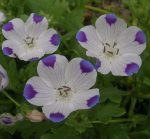 Also known as five-spot baby or buffalo eyes, this trailing annual is endemic to California where it grows primarily in meadows and woodlands of the Sierra foothills. It is a member of the borage family, Boraginaceae, that also includes forget-me-not, Siberian bugloss, and lungwort. The hairy, bushy plants grow 4-10″ tall and have pinnately lobed leaves that are up to 1″ long. From spring to mid summer, terminal bell-shaped flowers appear. They are up to 2″ in diameter and have five white petals, each with bluish to purple veins and a spot at the tip. The spots attract their primary pollinators, solitary bees. The fruits is capsule containing 12 greenish brown seeds. Plants tend to reseed readily. Five spot does best in cool weather with morning sun and afternoon shade. It is a good choice for a groundcover especially over bulbs, as well as for cottage, wildflower, wildlife or meadow gardens. The genus name, Nemophila, comes from the Latin word nemus, meaning grove or wooded glade, and the Greek word philos, meaning loving. The specific epithet, maculata is the Latin word meaning spotted and refers to the markings on the petals.
Also known as five-spot baby or buffalo eyes, this trailing annual is endemic to California where it grows primarily in meadows and woodlands of the Sierra foothills. It is a member of the borage family, Boraginaceae, that also includes forget-me-not, Siberian bugloss, and lungwort. The hairy, bushy plants grow 4-10″ tall and have pinnately lobed leaves that are up to 1″ long. From spring to mid summer, terminal bell-shaped flowers appear. They are up to 2″ in diameter and have five white petals, each with bluish to purple veins and a spot at the tip. The spots attract their primary pollinators, solitary bees. The fruits is capsule containing 12 greenish brown seeds. Plants tend to reseed readily. Five spot does best in cool weather with morning sun and afternoon shade. It is a good choice for a groundcover especially over bulbs, as well as for cottage, wildflower, wildlife or meadow gardens. The genus name, Nemophila, comes from the Latin word nemus, meaning grove or wooded glade, and the Greek word philos, meaning loving. The specific epithet, maculata is the Latin word meaning spotted and refers to the markings on the petals.
Type: Annual
Bloom: Terminal cup-shaped flowers with 5 white petals marked by purplish veins and a prominent spot on the to tip, from spring to mid-summer
Size: 4-10″ H x 12″ W
Light: Full sun with afternoon shade
Soil: Average, medium moist to dry, well-drained
Hardiness: Not hardy; annual
Care: Low maintenance
Pests and Diseases: Aphids
Propagation: Sow seed in fall where winters are mild; otherwise sow in early spring.
Companion Plants: Sticky cinquefoil, desert rock purselane, blue eyed grass
Photo Credit:Wikimedia